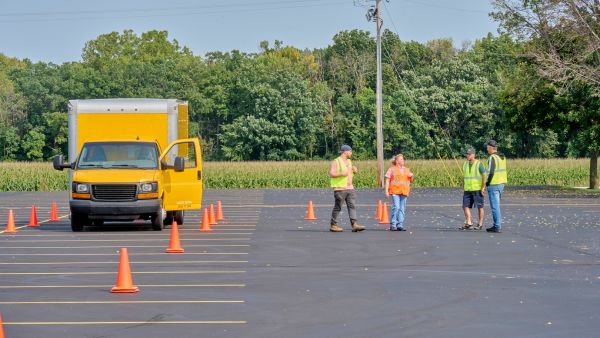How to Build a Driver Training Course and Program
Tom Bray, Sr. Industry Business Advisor
February 19, 2024

Getting drivers time behind the wheel in a safe environment is a critical element of any effective training program. The first step to building your own driver training course is by answering these questions:
- Do you want a training course to assist your new drivers in passing their CDL skills testing?
- Do you want one so you can train and evaluate your drivers operating in realistic, high-risk situations?
- Do you want a course that can be used to evaluate new drivers and weed out the ones that don’t have adequate skills during orientation?
The answer to these questions will help you determine what exercises you use, your layout, and how much room you will need.
When laying out your training course, you’ll want to consider these four safety tips:
- Avoid maneuvers near people or high-value property
- Avoid yard vehicles operating in a public area
- Limit access to the range by keeping the area separated using gates or signs
- Require anyone on the range to wear high-visibility clothing
Ideally, you’ll want to set up a “flow” to your training course, so vehicles can move from exercise to exercise efficiently. A common layout is to have forward maneuvers placed between backing maneuvers. This way, the driver will be doing forward maneuvers (turns or offsets) while moving to the next backing exercise.
Once your closed-course driver training range is set up, incorporate these exercise ideas:
- Tight left and right turns: Allows the driver to learn how to position the vehicle at the beginning of a turn and when to start turning, how to use the mirrors during a turn, and to make steering corrections during a turn. Allows the trainer to assess the driver’s ability to use correct procedure when turning and the driver’s overall turning skills.
- Forward stop line: Allows the driver to learn where the front of the vehicle is compared to a fixed point. Allows the trainer to evaluate the driver’s forward judgment.
- Straight line backing: Allows the driver to learn the basics of backing and mirror use while backing. Allows the trainer to easily evaluate the learner’s mirror use and control habits.
- Forward offsets (left and right): Allows the driver to learn how to use the mirrors and control the vehicle’s position while maneuvering to the sides. Allows the trainer to evaluate the learner’s ability to use the mirrors and make steering adjustments to control the vehicle’s path through a constricted area requiring maneuvering.
- Offset backing (left and right, sometimes called parallel parking): Allows the driver to learn how to control the vehicle in a slow, extended backward change of direction. Allows the trainer to evaluate the driver’s ability to control the vehicles path over an extended distance while backing.
- 45-degree curved back: Allows the driver to learn the “standard” curved docking approach used in the industry. Allows the trainer to see if the driver can control the vehicle on a sharp curved path.
- 90-degree curved back (also known as jackknife backing): Allows the driver to learn control of the vehicle and the vehicle’s path while making a sharp backward turn. Allows the trainer to see if the driver can control the vehicle in an extremely sharp and difficult backward turn.
- Serpentine backing: Allows the driver to learn how to maneuver around an obstacle or series of obstacles. Allows the trainer to see if the driver can keep track of multiple hazards and use multiple visual inputs to make steering decisions.
Setting up a training course that facilitates these exercises will help your drivers avoid the most common accidents turning and backing and better prepare them for real-world scenarios.
J. J. Keller’s veteran trainers can help you assess your current training and help implement effective defensive driving strategies, including setting up training courses like described in this article. The result is a reduced risk of accidents, improved safety, and protection of the company's bottom line.